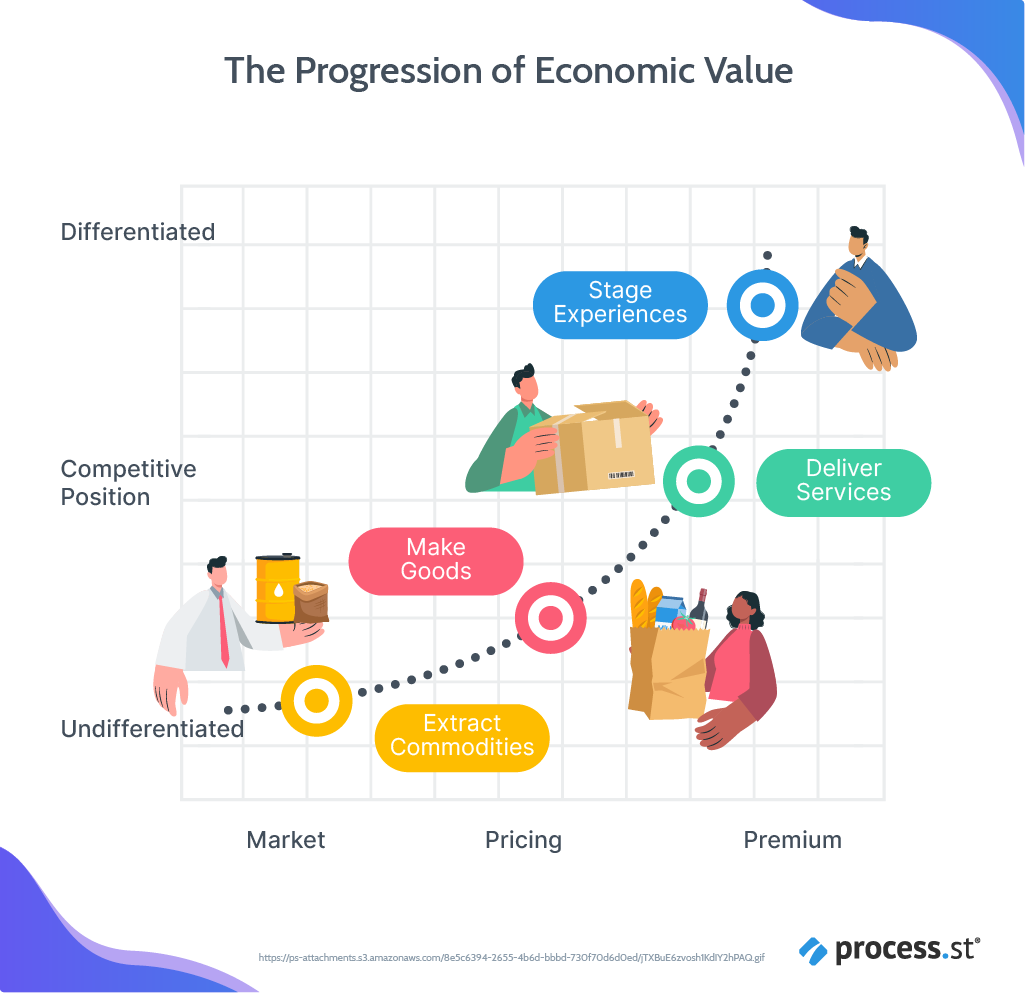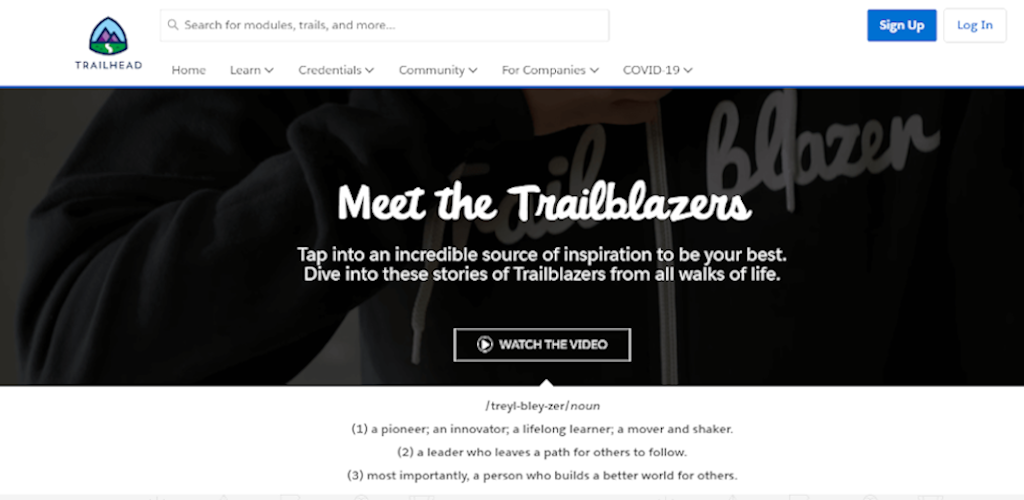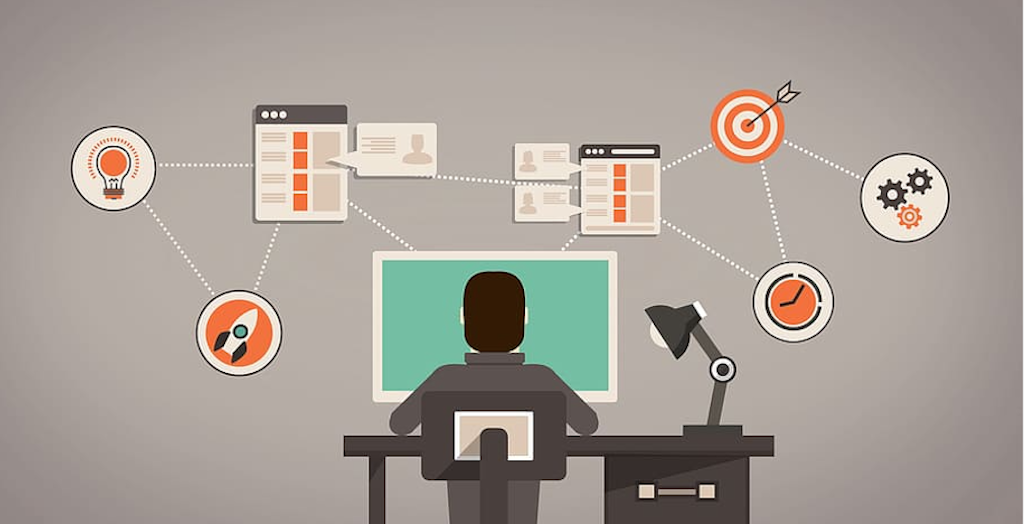
Hello, and welcome readers to the experience economy.
Take my hand and I’ll guide you to a place of psychic gratification. Feel your senses tingle, and your attention sharpen. You’re entering a new chapter of customer success, one that’s immersive and marks the next economic stage.
Businesses are no longer competing on a commodity level. In a digital world, with growing immersive processing power, organizations must crack the whip and adopt the experience mindset. This is a mindset that’s focused on customer success and delivering exceptional experiences instead of commodities.
In this Process Street article, we take a look at how one particular tech unicorn is succeeding in this experience economy.
You got it, I’m talking about the tech-tycoon Salesforce.
Salesforce is one of the largest tech companies to date with over 49,000 employees in 28 countries and has built the world’s most demanded CRM. Part of Salesforce’s triumph lies in the organization’s customer success capabilities. And today, you will learn how they’ve perfected customer success using principles from the experience economy.
Grab onto your seatbelts as you’re about to be blown away!
- What is the experience economy?
- 8 ways Salesforce achieves complete customer engagement in our experience economy
What is the experience economy?
The experience economy is a marketplace where organizations compete, not with the commodities they provide, but with the experiences they create for their customers.

A good example is the Simon DeBartolo Group, an American real estate investment trust with a portfolio of shopping malls, outlet stores, community, and lifestyle centers. The malls of the DeBartolo Group offer a different experience to your standard shopping center. These malls use a panoply of architectural effects, which include marble floors, stark white pillars, “outdoor” cafes, living trees – which nature-loving me highly appreciates – and flowing fountains. Every mall front is an elaborated Roman re-creation. Statues of Caesar and other Roman luminaries come to life and speak, “hail, Caesar!” while Roman centurions periodically march through the walkways.
With the Simon DeBartolo Group, shopping never feels like a chore. It’s a fun experience.
The term experience economy was first used in 1998 by authors B Joseph Pine and James Gilmore.
In their book The Experience Economy, Pine and Gilmore argue that businesses must orchestrate memorable events for their customers, and that memory itself becomes a product of the experience.
A transformation has taken place. Customers no longer demand goods to serve a function, but look for goods that deliver functions with individual experiences. This demand for experience has created the experience market. This is the next step in what’s deemed as progression in economic value.
The progression of economic value

Unless companies want to become commoditized, they need to upgrade and deliver the next economic value. Prior economic offerings – such as commodities, goods, and services – are tangible and cannot give a truly differentiated output.
- The commodity mindset: Business is merely performing a function (i.e. to get the user from point A to point B.)
- The experience mindset: Business moves beyond function and provides an experience.
You’re invited to witness how the experience economy has progressed over the years. Come and join us as we’re about to host a party!
You’re invited – let’s have a blast!
As a vestige of the agrarian economy, parents made birthday cakes from scratch, mixing farm commodities (milk, flour, eggs, and butter) costing a small dime. As the goods-based industry expanded, parents began to pay a little more for pre-made mixtures.
Use this mixture, whip up an egg, and va-va-voom you have yourself a cracking cake.
Moving on, the service economy takes over. We have busy parents purchasing premade cakes with a hefty price tag.
Today, parents aren’t making the cake. They aren’t even going to the store to buy one. Nor are they blowing up the balloons, making a playlist, and cramming around the treats cupboard for party bag fillers.
They are spending a lot more money to outsource the entire event in places like Disney World and Discovery Zone. Parents are buying the entire birthday experience.
Our party has transitioned into the experience economy.
Economic distinctions: The four realms of customer experience
We can sort experiences out into four broad categories according to where they fall along a spectrum.

This spectrum of division is as follows:
- Entertainment: An example would be watching TV, or reading this article. This is passive as you’re not involved in the event, nor do you affect the outcome. It’s absorbing as your attention is attuned, but it’s not immersive as your not entering a new, augumented environment.
- Educational: An example would be attending a university lecture. These experiences are more active as you’re involved in the event and make a difference in its outcome. The experience is absorbing as you’re engrossed with the information that’s communicated to you – unless it’s a dull lecture.
- Esthetic: Esthetic comes when your participation is removed from an immersive experience. To be immersed means to enter a new or augmented environment. For instance, if you go on a safari, then this would be immersive, but you don’t have an impact on the event meaning you’re a passive participant.
- Escapist: An escapist event is immersive, but demands active participation by yourself. This could be playing in an orchestra or watching a football event. Your contribution to these events will shape the experience. You’re also in a new, augmented environment.
Generally, the richest experiences encompass all four realms of experience.
Rich experience examples include going to Disney World, gambling in Las Vegas, or climbing a mountain. These experiences gain a sweet spot around the area where the experience spectrums meet.
Hitting this sweet spot isn’t easy, but it’s achievable.
Salesforce acts as a prime example of how you can adjust your customer success strategies, to deliver in the experience economy. The remainder of this article explains how Salesforce does this.
8 ways Salesforce achieves complete customer engagement in our experience economy
“I really like the [Salesforce] software because it brings me countless benefits with 100% functionality…and an unbeatable service…[Salesforce] saves me time and allows me to meet the needs of my clients, thus offering a unique and unmatched experience.” – Luisa S, G2 Review
As Luisa S says, Salesforce offers a “unique and unmatched” experience. The team at Salesforce delivers these unique customer experiences by using the experience economy for their customer success operations.
Salesforce does this by hosting:
- Help sites
- In-app help prompts
- Communities
- CSM/Account management
- Tower tours
- Media content/Appearances
- Forums
- Dreamforce
Let’s have a look at each of the above in more detail, and see how – when delivered together – Salesforce hits the sweet spot in terms of customer success, engagement, and delivering an unmatched experience.
Help sites deliver an educational experience for the Salesforce customer

Salesforce’s help site is a web platform that offers informative documents, videos, interactive tutorials, and walkthroughs. These resources are designed to educate and help you succeed in using the Salesforce CRM.
How do help sites deliver an educational experience for the Salesforce customer?
The different resources offered on the Salesforce help site mean customers can design the experience they want. That is, the experience is self-led.
Maybe they want to take part in an interactive tutorial, or maybe they prefer to sit and read an informative document. By having this interactive power, Salesforce has delivered an active experience.
The customers are not immersed in a new, augmented environment, instead, they are observing something from the outside. Because what they’re observing will help them achieve their CRM goals, they will be absorbed in the information provided to them. To conclude we have an educational experience.
Educational = Passive Participation + Absorption
In-app help prompts deliver an educational experience for the Salesforce customer

When using the Salesforce platform, customers are prompted with pop-ups on how to do certain tasks, and use certain Salesforce features. The prompts are designed to lead the customer down a path of best practice towards their ‘A-ha!’ moment.
Help prompts give Salesforce users tidbits of knowledge they can apply while using the software.
How do in-app help prompts deliver an educational experience for the Salesforce customer?
As with help sites, customers are observing the information given from an online platform. They’re outsiders absorbing the pop-up information. Hence they are not immersed in the experience. The information given is useful and helps the customers achieve their aim with the Salesforce CRM, and is hence absorbing.
The prompts delivered are dependent on the customer’s activity in the Salesforce application. This means customers can shape what prompts are delivered to them, resulting in active participation.
Communities deliver an escapist experience for the Salesforce customer

Salesforce Trailblazer community is an online platform designed to connect users. Community members can go onto the Trailblazer platform, find the relevant community, and then search feeds, groups, and topics for upcoming events. These events take place in person, where Salesforce pays community members to go out and have fun with other members.
Through their communities, Salesforce orchestrates supportive groups to deliver a positive experience to their customers. In a sense, Salesforce has managed to create a movement.
How do communities deliver an escapist experience for the Salesforce customer?
Communities give people a sense of purpose and an escape from their everyday lives. Meeting up in person creates an immersive experience as members physically remove themselves from their routine to congregate, have fun, and learn.
This experience is active on the participant’s side. Community involvement is the responsibility of the community members. Customers get out what they put in. Salesforce merely provides the platform to support and help users organize their escapist experience.
Escapism = Active Participation + Immersion
Salesforce CS/Account management delivers an educational experience for the Salesforce customer

When a customer sets up their Salesforce account, they’re assigned to a Customer Success/Account Manager. This means customers have a dedicated team behind them, assisting them on their Salesforce journey.
Customers can come to the CS/Account Manager if they have any questions or issues. This is part of their Salesforce experience.
How do CS/Account Managers provide an educational experience for the Salesforce customer?
Customers communicate with CS/Account managers to resolve their issues and achieve their goals. This communication is two-way and demands active participation from the customer.
The collaboration between the CS/Account Manager and the customer does not rely on an augmented environment, making the experience educational rather and escapist.
Media content and appearances deliver an entertaining experience to the Salesforce customer

If you haven’t already, I would recommend you check out the Salesforce blog. There’s a wealth of entertaining articles to engross you. Salesforce also has a Youtube Channel, hosts webinars, and often attends external events as guest speakers. For instance, check out Mark Benioff‘s – CEO of Salesforce – talk at Goldman Sachs or his appearance at CNBC.
How do media content and appearances provide an entertaining experience to the Salesforce customer?
The media content, webinars, and appearances are viewed by customers, who are on the outside. The customers are not immersed in a new environment, but the experience is absorbing.
Customers have no impact on the event and act as passive participants.
Entertainment = Passive Participation + Absorbing
Forums deliver an educational experience to the Salesforce customer

Salesforce hosts several different forums to help their customers collaborate, and get the answers they need from other users. These forums include Salesforce’s Customer Collaboration Forum, Developer Forum, and a Discussion Forum.
How do forums provide an educational experience to the Salesforce customer?
The communities and forums hosted by Salesforce are all about providing a platform dedicated to collaboration, idea sharing, communication, and peer-to-peer education. This education is driven by the users, making the experience active.
Because the users aren’t immersed in a new environment, these experiences are not Escapist experiences. They are educational, using absorbing information from the outside.
Dreamforce delivers an escapist experience for the Salesforce customer
Dreamforce is an annual Salesforce event. The event brings Salesforce users together for learning, fun, community building, and philanthropy.
Dreamforce aims to teach, inspire, give back and provide fun for Salesforce customers. This is achieved by:
- Running breakout sessions, training, and certification opportunities;
- Inspiring attendees by hosting talks from the world’s most innovative minds;
- Helping attendees build diversity, inclusion, equality, and sustainability with action and volunteerism;
- Hosting a party in celebration of the Salesforce community for fun.
How does the Dreamforce event provide an escapist experience for the Salesforce customer?
Participants of the Dreamforce event are immersed in a new environment; one that has been carefully designed, planned, and augmented by the Salesforce team. In this new world, participants are allowed to let go, forget the outside world, and truly find themselves immersed in the experience.
The presence of the attendees gives life and soul to the Dreamforce celebration. Without participation, there would be no event. Once more, the quality of this participation (the enthusiasm and spirit) alters the experience Dreamforce creates. Hence participants are active participants.
To summarize, Salesforce uses different strategies and platforms for customer engagement. By doing they’ve managed to create entertaining, educational, and escapist experiences. Yet, what about esthetic experiences?
Remember an esthetic experience is immersive and requires no participation. It’s difficult for SaaS companies – like Salesforce – to provide such experiences because their offering is mostly in The Cloud. And I’m sorry to say, we can’t immerse people in The Cloud… yet.
No, we’re not digitizing humans, but there’s another way SaaS companies can provide esthetic experiences…something that Salesforce has managed to do.
The answer comes from holding conferences, like Dreamforce.
Esthetic: Passive Participation + Immersive
In fact, the Dreamforce event manages to use every four realm of experience by itself. This one event rises to the demands of the experience economy.
How the Dreamforce event delivers four realms of experience
We know that Dreamforce is an escapist experience when considered as a whole. But if we break the event down into its constituent parts, you’ll see the event itself incorporates all four experience realms:
- Entertainment: The Dreamforce event is used as a platform to announce important Salesforce updates and new features using on-screen demonstrations. These demonstrations are presented with participants looking on from the outside (absorbed, not immersed). Participants have no impact on these updates/new feature demonstrations, hence they are passive participants.
- Esthetic: Dreamforce creates a new environment to host the event. For instance, a Dreamforce “National Park” is created for the participants to walk around in and admire. In this instance, the participants are immersed in the Dreamforce experience, but they have no impact on the experience this augmented world creates. Hence, they are passive participants.
- Educational: Dreamforce hosts talks from industry experts. These talks are watched by the participants from the outside. Participants are absorbed in the experience but are not part of it. The participants are active, as they interact with the speaker and therefore shape the outcome of the experience.
- Escapism: A Dreamforce event wouldn’t be a Dreamforce event without the ending party. Participants are engulfed by the social event – they’re immersed – and their presence directly impacts the party’s success – no one likes a dead celebration.
In conclusion, using Salesforce as an example, you can see how it’s possible to target all four realms of experience to optimize customer success. You can do this by:
- Providing multiple customer touchpoints that target different spectrums of experience.
- Host a single event to deliver all four realms of experience in itself.
How was your experience? Evaluate your customer success operations to deliver optimized experiences
How did you find this article? What was your experience?
I can tell you, you’ve been a great passive and absorptive audience.
If you’re not thinking about experiences when designing your customer success strategies, then start. And start today.
Delivering on the four realms of experience will differentiate you as a brand that offers a customer premium.
The experience economy is unfolding. Top corporations like Salesforce are tackling this change as an opportunity. And so can you.
Adopt the same 8 customer success techniques as Salesforce and you’ll be on your way to lead in the experience economy.
Use your creative powers, be industry shakers, and deliver mind-blowing experiences!
Do you incorporate the four realms of experience when strategizing for customer success? What techniques do you use to deliver exceptional experiences? Let us know in the comments below!







 Workflows
Workflows Projects
Projects Data Sets
Data Sets Forms
Forms Pages
Pages Automations
Automations Analytics
Analytics Apps
Apps Integrations
Integrations
 Property management
Property management
 Human resources
Human resources
 Customer management
Customer management
 Information technology
Information technology



Jane Courtnell
Hi there, I am a Junior Content Writer at Process Street. I graduated in Biology, specializing in Environmental Science at Imperial College London. During my degree, I developed an enthusiasm for writing to communicate environmental issues. I continued my studies at Imperial College's Business School, and with this, my writing progressed looking at sustainability in a business sense. When I am not writing I enjoy being in the mountains, running and rock climbing. Follow me at @JaneCourtnell.